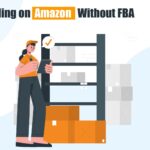After listing your product on Amazon, you need to create a shipment plan for sending your stock to the Amazon fulfillment center as you have chosen to be an FBA seller. I will guide you today through the intricate details of creating a shipment plan on Amazon FBA.
If your shipment plan is not right then the Amazon fulfillment center will refuse to accept the inventory you have shipped and this will cause extra expense in your pocket.
Furthermore, this delay will cause your Amazon listings to get deranked and you will incur extra marketing expenses to uplift your product.
I am eager to share my experience and knowledge about Amazon’s FBA shipment plan with all of you, so you can avoid any errors that might lead to rejection by Amazon’s fulfillment centers. Let’s ensure your shipment plans are error-free and smooth.
What Is Shipment Plan on Amazon?
A shipment plan on Amazon refers to the process of creating and organizing a detailed plan for sending your products to Amazon’s fulfillment centers. When selling through Amazon’s FBA (Fulfillment by Amazon) program, you need to prepare and ship your inventory to Amazon’s warehouses.
This shipment plan provides stock details to Amazon’s warehouse team so they can identify your stock and store it according to your listing.
Furthermore, the shipment plan allows you to specify the quantity, packaging, and shipping details for each product. It helps ensure efficient handling, storage, and delivery of your products to customers once they are ordered.
Properly creating a shipment plan is crucial for smooth operations and maximizing your chances of success on the Amazon platform.
Requirements: Amazon Preparing for Shipment
Before creating the shipment plan you must know how to prepare for Amazon shipment. Amazon has given strict guidelines about preparations.
Ensuring proper packaging of your shipment is essential to guarantee the safe arrival of your inventory and to optimize its entry into Amazon fulfillment centers. Below you will find all the guidelines related to preparations.
Prepping Supplies
The first thing to note is if you have all the supplies available for prepping your stock for Amazon shipment.
- Boxes
- Poly bags (minimum thickness of 1.5 mils)
- Opaque bags (specifically for adult products)
- Bubble wrap
- Tape
- Packing materials (dunnage)
- Workstation for product and shipment preparation
- Printer (Amazon utilizes Zebra GX430t model printers with direct thermal setting)
- Weighing scale for boxes
- Measuring tape for box measurements
- Printed copies of the Prep Matrix and Shipping Matrix
- Amazon barcodes (if applicable, printed from your account)
- Packing slip paper
- Labels for “Sold as Set” or “Ready to Ship”
Amazon Packaging Requirements of Units
Please adhere to the following general requirements when shipping units to our fulfillment centers.
- Ensure that every FNSKU used on a unit is unique and corresponds to a distinct product. For instance, different assortment types, such as size or color, must possess different FNSKUs.
- Each unit must feature an external barcode or label that can be easily scanned and includes both a scannable barcode and human-readable numbers. For more details, please refer to the FBA product barcode requirements.
- Take measures to remove, cover, or make any existing scannable barcodes on the outer surface of shipping boxes unscannable. For instance, you can use opaque tape to cover existing barcodes. This precautionary step ensures that incorrect barcodes are not accidentally scanned during the receiving process.
Amazon Packaging Requirements for Loose Products
Every unit, including multiple-volume book sets, must be securely packaged within a single package.
- Amazon does not accept units that would necessitate the assembly of multiple pieces by Amazon, such as wheelbarrows with separate handles and legs that are sold as a single piece.
- Units that are not enclosed in secure packagings, such as loose sleeves or pouches, must be placed in bags or secured using a non-adhesive band or removable tape.
- Footwear, regardless of the material, must be packaged in a way that ensures no part of the shoe is exposed. This can be done by using shoe boxes or poly bags with a suffocation warning.
Amazon Packaging Requirements for “Sold as Set”
Sets of units, such as a collection of six distinct toy cars that are sold as a single unit, must be appropriately labeled on their packaging. Attach a label to the unit that explicitly indicates that the products are intended to be received and sold as a unified set.
For instance, labels such as “Sold as set,” “Ready to ship,” or “This is a set. Do not separate” can be used to convey this information effectively.
Amazon Packaging Requirements for “Boxed Units”
The box must possess six sides and should have openings or a lid that remains securely closed without easily opening on its own. If the box tends to open on its own, utilize tape, glue, or staples to keep it properly sealed.
The box must not collapse when subjected to medium pressure on any of its sides.
In cases where the boxed unit includes perforated sides or openings, the product must successfully pass a 3-foot drop test. This test involves dropping the product once on each side and once on a corner.
If the product fails to pass the drop test, it must be enclosed in a poly bag accompanied by a suffocation warning.
Amazon Packaging Requirements for “Poly-Bagged Units”
Poly bags utilized for protecting units must meet the following criteria:
- Poly bags with an opening of 5 inches or larger (when measured in a flat state) must contain a suffocation warning. This warning can either be printed directly on the bag or attached as a label. Failure to include a suffocation warning may result in the items needing to be re-bagged.
An example warning message could be as follows:
“Warning: To prevent suffocation, keep this bag away from babies and children. Do not use this bag in cribs, beds, carriages, or playpens. This bag is not a toy.”
- The warning should be printed or positioned prominently on the bag, with a font size that is easily legible based on the size of the bag.
- The print size of the warning should conform to the specifications outlined in the provided table.
| Total length plus width of bag | Minimum print size |
| 60 inches or more | 24 point |
| 40 to 59 inches | 18 point |
| 30 to 39 inches | 14 point |
| less than 29 inches | 10 point |
- The bag’s thickness should be a minimum of 1.5 mil (thousandth of an inch).
- The poly bag must be transparent.
- It is required that the poly bag contains a scannable barcode (such as a UPC or EAN) or an X00-label that can be scanned through the bag. Alternatively, an X00- or ASIN label should be placed on the outside of the bag.
- Ensure that the poly bags are completely sealed.
- The poly bag or shrink wrap should not extend more than 3 inches beyond the dimensions of the product.
- For adult products, it is necessary to package them using black, opaque poly bagging or shrink wrap.
Amazon Packaging Requirements for “Bubble Wrap”
Products that are wrapped with bubble wrap must fulfill the following requirements:
- The bubble wrap should be tightly wrapped around the product and securely taped shut to prevent the product from falling out.
- The package should be labeled with a scannable barcode on the outside for easy identification.
- The product should be able to withstand a 3-foot drop test on a hard surface without its contents breaking. The drop test consists of five drops in different orientations:
- Flat on the base
- Flat on the top
- Flat on the longest side
- Flat on the shortest side
- On a corner
Bubble wrap may be necessary for the item due to the following reasons:
- Fragility: The item is delicate and could be easily damaged during transit.
- Weight or Density: The item is heavy or dense, posing a risk of damaging other items during transit.
Amazon Packaging Requirements for “Over-Boxing”
In cases where there are safety concerns regarding shipping and handling, Amazon may request the use of over-boxing. Over-boxing entails placing a prepared or packaged product in an additional box to provide enhanced protection, even if the product is already boxed.
For products weighing over 10 lb, it is recommended to use double-wall corrugated boxes for the over-boxing process.
Over-boxing is mandatory for the following types of products
- Sharp items, which have the potential to puncture packaging materials.
- Fragile items that have failed a 3-foot drop test even after being wrapped with bubble wrap or items that could be susceptible to damage during shipping and handling.
- Hazardous liquids in glass containers exceeding 4.2 oz.
- Vinyl records.
Amazon Packaging Requirements for “Hanger Removal”
Please remove regular-sized hangers from the shipment. However, mini-hangers for baby clothes are permissible. The following items should not be shipped while attached to any type of hanger: accessories, bras, hats, shorts, socks, hosiery, sweaters, swimwear, and underwear.
Amazon Packaging Requirements for “Tape”
For products that have this particular requirement, additional taping is necessary beyond the usual sealing of a box, poly bag, or securing bubble wrap around an item.
Extra taping may be needed in the following situations:
- When there is a risk of the item falling out of its packaging unless the container is securely taped shut.
- When there is a possibility of leakage if the lid is not properly taped in place.
- When the item is not completely sealed within its container.
Therefore, it is important to apply extra taping to address these concerns and ensure the safety and integrity of the product during transit.
Amazon Packaging Requirements for “Case-Packed Products”
- All products included in a box must possess matching SKU and condition, and they should have been packaged together by the manufacturer.
- Boxes containing the same product must maintain consistent quantities of that specific product. For instance, a case pack of 24 units should consistently contain 24 units.
- The maximum limit for case packs is 150 units per case.
- During the receiving process of such shipments, the fulfillment center scans one unit from the box, and subsequently, the entire box is added to the inventory. Scanning each unit is not necessary since they are all identical.
- Occasionally, a manufacturer or distributor might bundle multiple case packs into a larger box. However, these larger boxes do not qualify as a case pack and must be separated based on the appropriate case-pack level.
Individual Products or Case-Packed Products?
You must have a question in mind what is the difference between Individual Products and Case-Packed Products, these are two different ways of organizing and shipping products on Amazon. Let’s understand each of them.
Individual Products
This box represents multiple items of multiple individual listing getting shipped in one box. These individual products will have different UPC/EAN, ASIN and different products altogether for instance, Blue, Red and yellow polo tshirt.
Case Packed Products
This box represents multiple items of single individual listing getting shipped in one box. These case packed products will have one UPC/EAN and ASIN such as Blue polo tshirt
Amazon Packaging Requirements for “Expiration Dates”
- Expiration dates should be presented in either the MM-DD-YYYY or MM-YYYY format. If the expiration date is initially printed in a different format, it must be covered with a sticker displaying the correct format.
- Products with expiration dates must exhibit the expiration date on the outer box using a font size of 36-point or larger. Additionally, the expiration date should be present on the individual units. Relying solely on lot numbers is not sufficient.
- For expiration-dated products that necessitate additional preparation, such as poly-bagging or bubble wrap, labels containing the expiration dates must be affixed to the outer packaging or product preparation. This ensures that the expiration date remains accessible to Amazon associates during the check-in process.
- Perishable items are not permitted.
Further Points to Avoid: Marketing Materials and Safety
Amazon does not permit the inclusion of marketing materials, such as pre-priced labels, pamphlets, price tags, or any non-Amazon labels, with the shipments.
To avoid potential injuries caused by sharp objects inadvertently left in boxes, it is recommended to utilize safety knives equipped with covered blades while packing products.
Packaging Requirements of Boxes
Now you have learned how to pack each unit according to Amazon’s guidelines so we need to move further and guide you how to pack boxes and what are the rules for it.
Box Content Information
Including box content information enhances the inventory management process at Amazon, leading to quicker availability of your products for sale. Remember that if you fail to provide correct box content information then Amazon might block future shipments or add a manual processing fee to sort stock.
It is important to emphasize that precise box weight and dimensions are mandatory for all shipments, regardless of whether you choose to provide box content information in Seller Central or not.
Please ensure that each box is dedicated to inventory from a single shipment ID. It is important not to mix items from multiple shipments in the same box. You can locate the shipment ID on the Summary page corresponding to that particular shipment.
Verify that the shipment details listed on your shipping plan match the contents being sent to the fulfillment center. These details include:
- Merchant SKU
- UPC/EAN/ISBN or other external barcodes
- FNSKU
- Condition
- Quantity shipped
- Packing option (individually packed or case packed)
- Box weights and dimensions
Ensure that your units are prepared according to the requirements specified for packaging and prepping.
Rules for Packaging Shipments
All FBA sellers are required to oblige to the following instructions with which sellers can ensure that shipments will arrive intact and ready for processing at Amazon fulfillment centers
- Use a sturdy box with all six sides intact, including the flaps.
- Affix a single address label that displays complete delivery and return information.
- Each box included in the shipment must possess a unique FBA Box ID label, which can be printed from Shipping Queue.
- For each pallet, four FBA Pallet ID labels are required—one on the top center of each side. Additionally, each box on the pallet must have its own unique FBA Box ID label.
- When shipping multiple case packs in a larger box, apply the unique FBA Box ID shipping label on the exterior of the primary box.
- Remove any old shipping labels, barcodes, or markings if reusing boxes.
- Conceal existing barcodes using opaque tape or a black felt-tip marker to render them unscannable, preventing accidental scanning of incorrect barcodes during the receiving process.
- Wrap each item individually.
- Use sufficient packaging material.
- Employ strong tape specifically designed for shipping purposes.
- Maintain at least 2 inches of cushioning between each item and the interior of the box.
- After packing your box, gently shake it to ensure that the contents do not move.
- Using boxes with dimensions measuring at least 6 x 4 x 1 inches and weighing at least 1 lb can minimize receiving delays.
- Boxes must not exceed the maximum size and weight requirements, which are no more than 25.00 inches on any side and a total weight of no more than 50.00 lb, unless the box contains an individual oversize item that surpasses these limits.
Approved Standard Boxes to Hold Units
Following Boxes are approved
- Regular Slotted Carton (RSC)
- B flute Boxes
- ECT-32 (Edge Crush Test)
- It should have a burst strength of 200 lb./sq. inch.
To ensure safe shipping, it is recommended to use at least 2 inches of suitable packing material around each item and between the products and the box walls.
However, if your items are shipped in the manufacturer’s case pack, the additional 2 inches of packing material is not required.
Amazon FBA Box Size Limit
Boxes that contain multiple standard-size items or oversized items should not exceed 25.00 inches in any dimension. However, a box can surpass the 25.00 inch limit if it contains oversize units that are longer than 25.00 inches.
It is important to note that boxes that are excessively large compared to the oversize units, and exceed the recommended 2 inches of cushioning mentioned earlier, may face shipping restrictions, additional fees, or be refused at a fulfillment center.
Box Weight
It is important to accurately weigh and measure boxes and pallets, ensuring that the correct values are provided for each shipment. Additionally, all cartons must adhere to the following weight requirements
- Boxes should generally not exceed the standard weight limit of 50.00 lb. However, if a box contains a single item that exceeds 50.00 lb, it should have a label clearly indicating “Team Lift” attached to the top and sides of the box.
- If a single item within a box exceeds 100.00 lb, a label indicating “Mechanical Lift” should be clearly attached to the top and sides of the box.
- Boxes containing jewelry or watches must not exceed 40.00 lb in weight.
Please note that the UPS allowances for larger box dimensions and weight do not apply to boxes that contain multiple standard-size items.
How To Create A New Shipping Plan?
If you have gone through the above guidelines thoroughly on how to prepare for Amazon shipment then you are ready to create a shipment plan on Amazon seller central.
Creating a shipment plan is really easy.
You must receive all the following information from your manufacturer or supplier,
- Address: Ship from
- Choose case packed or individual units
- Quantity per box
- Box dimensions
- Box weight
- Total boxes
When you have all these information then you need to do the following,
- Login to your Amazon seller central account
- Click on top left corner and go to manage inventory
- Select the product that you need to replenish
- Click on send/replenish inventory
- Then you need to enter all the details mentioned above
- Then you need to confirm shipment and print box labels
- Finally you need to confirm carrier
Amazon Partnered Carrier vs Non Partnered Carrier
When you are required to choose carrier for your shipment then you can choose either Amazon partnered carrier or non partnered carrier. Before choosing any you need to monitor the rates, delivery time and other factors for selecting the right carrier.
Here are some attributes for both carriers.
Partnered Carriers
Amazon has established partnerships with various shipping carriers to provide discounted rates and streamlined shipping processes for sellers. The partnered carriers include well-known companies like UPS, FedEx, and DHL.
When using Amazon partnered carrier, sellers can access negotiated rates, automated tracking information, and other benefits.
Advantages of partnered carriers
- Discounted shipping rates: Amazon’s partnerships allow sellers to access lower shipping rates, which can help reduce overall shipping costs.
- Integrated tracking: Partnered carriers automatically update tracking information in the seller’s Amazon account, providing visibility to both sellers and customers.
- Prepaid label options: Sellers can use prepaid labels for easier and faster shipping.
Non-Partnered Carriers
Non-partnered carriers refer to shipping services that are not directly integrated with Amazon’s system. These carriers can be any shipping service providers chosen by sellers, such as regional couriers or independent shipping companies.
Advantages of non-partnered carriers
- Flexibility: Sellers have the freedom to choose the carrier that best suits their needs, regardless of whether they have a partnership with Amazon.
- Regional options: Non-partnered carriers can be beneficial for sellers who operate in specific regions or have unique shipping requirements not covered by the partnered carriers.
- Negotiation opportunities: Sellers may have the ability to negotiate shipping rates and terms directly with non-partnered carriers.
It’s important to note that the availability of partnered carriers may vary depending on the seller’s location and the specific Amazon marketplace they are using.
Should I Choose Small Parcel Delivery (SPD) Or Less Than Truckload (LTL) While Creating Shipment Plan?
While creating shipment you always need to select SPD or LTL. Before selecting any, you need to understand when you should choose SPD and when you should choose LTL.
Small parcel deliveries (SPDs)
This involve packaging units in separate boxes, with each box being labeled individually for transportation. These shipments are typically smaller in size and are commonly sent through carriers like DHL, UPS, FedEx, or local postal services.
When using a partnered carrier for small parcel delivery (SPD), there is a limit of 200 boxes per shipment. Conversely, when opting for a non-partnered carrier for small parcel delivery (SPD), the limit per shipment increases to 500 boxes.
Less than truckload (LTL)
Sellers typically use Less than Truckload (LTL) shipping for Amazon shipments when they have larger quantities of products that do not require a full truckload but are too bulky or heavy to be shipped as small parcel deliveries.
LTL shipping is a cost-effective option for shipping goods that occupy a significant portion of a truck’s space but not the entire capacity.
Amazon FBA Box Size Limit
To ensure compliance, a maximum of 5,000 boxes is allowed per LTL shipment. If you have more than 5,000 boxes to ship, you will need to create an additional shipment or select FTL for whole stock.








